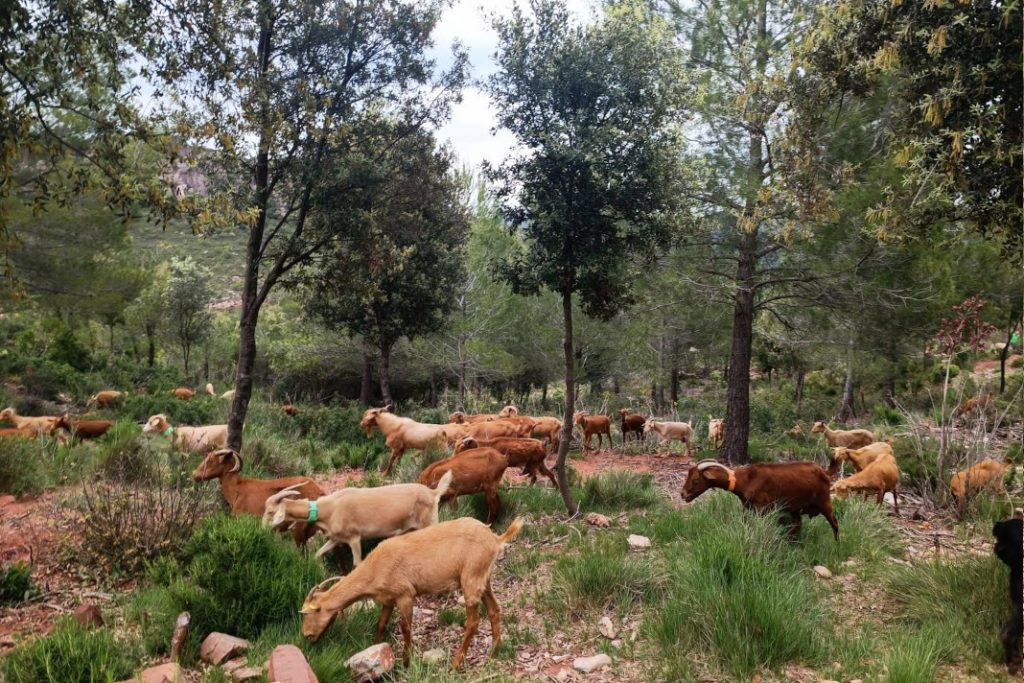Silvo-pastoralism and agroforestry are increasingly recognised as innovative, fire-smart practices in the Mediterranean, helping prevent large forest fires while promoting biodiversity conservation and enhancing resilience to climate change.
Silvo-pastoralism serves multiple purposes: it boosts land productivity, fosters stewardship, supports biodiversity conservation in open areas, and preserves traditional practices alongside mosaic landscape patterns.
As an agroforestry practice, silvo-pastoralism can thrive in various environments—cultivated areas, rangelands, woodlands, and heaths. These systems incorporate diverse plant components—trees, shrubs, grasses—and animal life. This environmental complexity mitigates climatic hazards by providing multiple resources for feeding and shelter, enhancing animal welfare and resilience. In Western economies, silvo-pastoralism plays a vital role in revitalising areas that might otherwise be abandoned, such as forests, mountainous regions, and arid Mediterranean zones. This system is particularly valuable in harsh conditions characterised by challenging relief, water scarcity, intense sunlight, and low soil quality.
Silvopasture can be created by either planting trees in existing pastures or establishing pastures in existing woodlands. Each method presents unique challenges.
Integrating trees into pasture
Planting trees in existing pastures involves several obstacles: young trees require protection from livestock, trees may take years to become productive, and introducing trees can limit future land-use options.
Integrating pasture into woodland
Transforming woodland to enhance pasture also presents challenges. The woodland often needs thinning to allow more light in, which can be time-consuming and may necessitate heavy machinery. Moreover, managing the resulting debris from felled trees is crucial. Thinned woodlands may experience a surge of weed and seedling growth that needs to be controlled to prevent overgrowth or overgrazing. Additionally, establishing pasture forages beneath the trees can be complex, particularly if trees have already been removed.
The role of Fo.Re.S.T.A.S. in silvo-pastoralism
The Fo.Re.S.T.A.S. Agency manages around 220,000 hectares of forest land in Sardinia and annually issues numerous pasture leases (“fide pascolo”). This activity directly supports traditional production chains (milk and meat), protects the territory, maintains traditional landscape patterns, and conserves high biodiversity, all while reducing combustible biomass.
Through the FIRE RES and ResAlliance projects, the Agency collaborates with research institutes to enhance fire prevention and landscape resilience against extreme wildfire events. This is achieved by employing goat herds to maintain low biomass levels in strategic areas (such as the wildland-urban interface, firebreaks, and buffers) that were previously managed through mechanical interventions. These innovative methods significantly reduce the labour required for thinning and shrub clearance.
Grazing is meticulously planned, defining specific spaces, methods, and timings in collaboration with shepherds. This transforms the relationship between breeders and the land; they shift from being mere consumers of forage to becoming providers of an essential ecosystem service—undergrowth clearing.
This operation incurs minimal costs but demands strong dialogue with local communities and a commitment to building trusting relationships with breeders, who should be compensated for their ecosystem services, much like in prescribed grazing schemes. This paradigm shift—from viewing breeders as a problem to recognising them as valuable resources—requires knowledge, strategic planning, and collaboration.
Visit ResAlliance’s official website
This article was originally written by:
Regional Forest Agency for Land and Environment of Sardinia (Fo.Re.STAS)
The post Silvo-pastoralism: A key tool for enhancing landscape resilience to forest fires appeared first on Resilience Blog.
